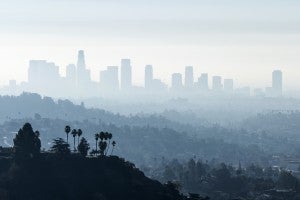By Peter Zalzal and David Lyon

With families across the country starting back to school this week, the official summer season may be gone, but the ozone season is still in full swing.
Ozone, more commonly known as “smog” is a harmful air pollutant that results in respiratory ailments like asthma and can even lead to premature death. For too many Americans, ozone pollution makes the activities that we enjoy doing outdoors in the summer difficult or even impossible. And in recent years, ozone—once a summertime phenomenon impacting mostly larger cities—now affects rural parts of the country and can persist throughout the year. In fact, rural Wyoming and Utah have experienced elevated ozone levels in the winter on par with some of the larger cities in the country.
A number of different industrial sources can contribute to this pollution, but in certain areas, emissions from the oil and natural gas sector are a significant factor. Fortunately, this summer, EPA finalized the nation’s first-ever standards for methane emissions from new and modified sources in the oil and natural gas sector–standards that will also reduce smog-forming volatile organic compounds (VOCs).
EPA has also proposed guidelines for states to help minimize smog-forming emissions from oil and gas infrastructure that is already in existence and located in certain areas with unhealthy levels of ozone pollution. These control techniques guidelines (CTGs) identify commonsense, highly cost-effective measures that are similar to those already being deployed by states like Colorado and Wyoming to cut smog pollution from the oil and gas sector and protect public health. The CTGs will also help to ensure that these sources do their part to reduce emissions and restore healthy air, and because they are guidelines, the CTGs simply require states to evaluate the merits of addressing particular emissions sources. Where states have different and more effective strategies to reduce oil and gas sector pollution, the guidelines help create a framework to evaluate and enable these state-based solutions.
We expect that the agency will soon finalize these requirements. Below are three things to look for in the final set of guidelines.
Leak Detection and Repair Requirements
Equipment leaks are a significant source of emissions from the oil and natural gas sector, and rigorous leak detection and repair (LDAR) standards are the cornerstone of any effective program to minimize these emissions.
In final standards applicable to new and modified sources, the agency made several improvements to strengthen LDAR requirements, including:
- increasing inspection frequencies for compressor stations;
- removing exemptions for low-producing wells; and
- removing provisions that allowed operators to reduce the frequency of inspections based on the percentage of components leaking at a site.
EPA should ensure these same improvements are reflected in final CTGs. Particularly as recent evidence, including measurements in ozone nonattainment areas, has underscored that low-producing wells can be a significant source of emissions.
Storage Tanks
Storage tanks are likewise an important source of smog-forming emissions. EPA should finalize protective guidelines for tanks that include a certification requirement, similar to the one the agency finalized in its methane regulations earlier this summer. This will help to ensure that tank controls are designed and sized properly. Recent evidence, including information from scientific studies and from the state of Colorado, suggests tank controls are often ineffective and so proper design of these controls, combined with frequent inspections, is necessary to minimize emissions.
Liquids Unloading Activities
EPA has not proposed guidelines applicable to liquids unloading activities, even though these too are a significant source of smog-forming emissions. These practices are designed to restore production in lower producing wells and can involve substantial venting of gas (sometimes in excess of 10 percent of a wells production). Colorado and Wyoming require operators of new and existing wells to undertake steps to limit emissions from liquids unloading activities. Moreover, the flexibility EPA has in crafting guidelines could allow the agency to pursue an approach focused on best management practices, much like the standards in place in these leading states.
EPA’s CTGs are an indispensable, highly-cost effective, and flexible tool that can help protect the health of communities that face elevated levels of ozone pollution. It is critical that EPA move forward with protective final guidelines that provide state air quality planners with tools to reduce this pollution from the oil and natural gas sector.










One Comment
I agree with you. I have seen smog getting worse all over the country. I travel for work and I am surprised how bad the air is in some more rural part of the country. I also think increasing automotive regulations can help reduce pollution a lot. I wish everyone would go to EA smog regulations.